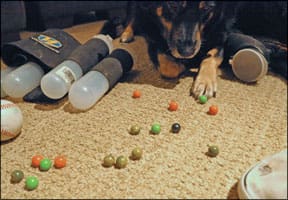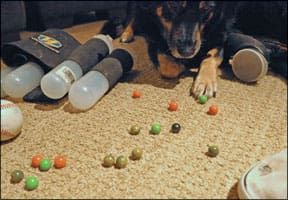Warning: Paintballs are Toxic to Dogs
Ingesting paintballs can lead to seizures and even death.
My dog Ella and I spent an anxious night at the emergency clinic recently, after she found and ate paintballs while on our walk. She was off-lead at the time, so when I realized what she was doing, I had no way of knowing how many she had eaten. In fact, I did not immediately recognize the colorful, marble-sized gelatinous balls, and thought they were some kind of candy. It was only a few hours later, when she threw up bright turquoise, that I became concerned and investigated further.

Paintballs ingredients can include polyethylene glycol, dipropylene glycol, glycerol, and sorbitol, all osmotic laxatives, which can lead to hypernatremia (“salt poisoning”) when ingested in sufficient quantity. These ingredients also taste sweet, which is why dogs find paintballs so attractive.
Signs of paintball toxicity are usually neurological, a result of the movement of water out of the brain, leading to hemorrhage. The most common signs include vomiting, ataxia (loss of coordination), and diarrhea. These can occur as early as 30 minutes after ingestion, but more commonly show up within two to four hours. Other signs may include tremors, rapid heart rate, weakness, hyperactivity, fever, blindness, and seizures. Blood tests may show elevated sodium and chloride, low potassium, and metabolic acidosis.
The number of paintballs needed to cause clinical signs is unknown. In one case, a 90-pound Labrador Retriever showed signs after ingesting 15 paintballs. As few as 5 to 10 paintballs may cause signs in dogs weighing around 65 pounds.
Vomiting should be induced if it has been less than an hour since the paintballs were ingested (activated charcoal is not recommended). If the number of paintballs the dog ate is either unknown or relatively high for the dog’s size, or if any clinical signs are seen, it’s best to get the dog to a vet right away for testing and treatment. There, IV fluids are given to help dilute and flush out the toxins, and electrolytes and acid-base balance are monitored every two to four hours. Additional treatment may include drugs to control seizures and vomiting; warm-water enemas to help move the paintballs through the digestive tract more quickly (especially for dogs with elevated sodium levels); and therapy as needed for low potassium, high fever, or acidosis. While the ingestion of paintballs can be fatal, most dogs recover within 24 hours with proper care.
Because I was unsure how many paintballs Ella had ingested, and because of her small size (11 pounds), both my own vet and the Pet Poison Helpline I called recommended taking her to the emergency clinic right away and keeping her on fluids for 24 hours. Luckily, her electrolytes were never more than mildly out of range, and she had no further symptoms. Her bright green stool the next day showed evidence of only one paintball, but I don’t regret the precautions I took, which I’m sure helped her recovery and gave me peace of mind.
– Mary Straus
For more information: Paintball Toxicosis in Dogs www2.aspca.org/site/DocServer/ toxbrief1203.pdf?docID=1521
Veterinarians Join War on Cruelty
Univ. of Florida offers veterinary forensic science course
The field of veterinary forensics is growing. In 2008, the International Veterinary Forensic Science Association was founded; it will hold its third annual conference on veterinary forensics in Orlando, Florida, in May 2010. However, as yet, veterinary colleges provide little training in animal cruelty investigations for veterinary students. It’s tragic when testimony from a veterinarian can make the difference between a conviction or an acquittal in a cruelty case, and there are no qualified vets available to testify. Fortunately, educational resources for this area of expertise are about to get a boost.
The University of Florida has announced that in spring, under the guidance of Melinda Merck, DVM, senior director of veterinary forensics at the ASPCA, it will launch the nation’s first formal veterinary forensic science program. Dr. Merck assisted with the investigation into Michael Vick’s dogfighting activities, and her expertise helped put the NFL quarterback in prison. She is helping develop the University’s certificate program, which is part of its online master’s degree program in forensic science. The course will help veterinarians learn to recognize crimes against animals, and give them the tools to respond appropriately.
Approximately a dozen states mandate veterinarians to report suspicions of animal cruelty. Merck believes that even in those states where vets are not mandated reporters, they have a moral imperative to report.
According to Dr. Randall Lockwood, Ph.D., senior vice president of anti-cruelty field services at the ASPCA, a number of surveys indicate that every veterinarian will confront animal cruelty at some point in his/her career.
– Pat Miller
For more information: vetmed.ufl.edu/
FDA Issues Alert for Vetsulin
Owners need to check their diabetic dogs’ medication
On November 2, the FDA’s Center for Veterinary Medicine and Intervet/Schering Plough Animal Health began alerting veterinarians and pet owners to problems found with Vetsulin, a prescription insulin product used to treat diabetic pets.
Stability issues have led to variation in the amount of insulin contained in the product. Specifically, there may be too much crystalline insulin, which is the longer-acting component, and too little of the amorphous, short-acting insulin. This can lead to a delay in the insulin beginning to work, a delay in peak effect, or the insulin working longer than expected. The result may be either hypoglycemia or hyperglycermia.
Hypoglycemia (low blood sugar) is a medical emergency: if not corrected, it can be fatal. Symptoms of hypoglycemia can include disorientation, ataxia (loss of coordination or balance), weakness, lethargy, and seizures. If you suspect your dog is suffering from hypoglycemia, rub Karo syrup or honey on your dog’s gums or under the tongue and contact your veterinarian immediately.
Hyperglycemia is less of a concern, at least in the short term. It produces the same symptoms as are seen in diabetic dogs before beginning treatment, such as excess drinking and urination, increased appetite, and lethargy.
If you use Vetsulin to treat your diabetic pet, please contact your veterinarian right away about switching to a different product until these issues are resolved.
If your dog develops problems that your veterinarian believes could be linked to Vetsulin, they should be reported to the FDA and to Intervet/Shering-Plough Animal Health, the company that makes Vetsulin.
– Mary Straus
For more information: www.fda.gov/AnimalVeterinary/News Events/CVMUpdates/ucm188752.htm
Intervet/Shering-Plough Animal Health, 800-224-5318, vetsulin.com






